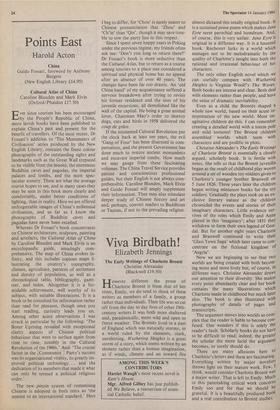Viva Birdbath!
Elizabeth Jennings
The Early Writings of Charlotte BronW Christine Alexander (Blackwell £19.50)
However different the prose of 1 'Charlotte Bronte is from that of her sister, Emily, we do tend to think of these writers as members of a family, a group rather than individuals. Their life was so cut off from the day to day lives of other 19th- century writers.lt was both more sheltered and, paradoxically, more wild and open to fierce weather, The Brontës lived in a part of England which was naturally stormy, in a world ruled by the elements, stark, unrelenting. Wuthering Heights is a great storm of a story, which seems written by an element rather than a human imagination, as if winds, climate and an inward fire almost dictated this totally original book. It is a sustained prose poem which makes Jane Eyre seem parochial and humdrum. And of course, this is very unfair. Jane Eyre is original in a different way. It is a haunted book. Rochester lurks in a world which manages not to be melodramatic by the quality of Charlotte's insight into both the rational and irrational behaviour of her characters.
The only other English novel which We can usefully compare with Wuthering Heights is Virginia Woolf's The Waves, Both books are intense and clear. Both deal with elements rather than people, and have the sense of dramatic inevitability.
Even as a child the Brontës shaped a whole new world, based on their acute in- terpretation of the new world. Most im- aginative children do this. I can remember creating a detailed world with a totem pole and mild tortures! The Bronte children assembled worlds which teem with characters and are prolific in plots.
Christine Alexander's The Early Writings of Charlotte Bronte is essentially a closely argued, scholarly book. It is fertile with notes. She tells us that the Bronte juvenilia began as the result of childhood play woven around a set of wooden toy soldiers given to Charlotte's younger brother Branwell on 5 June 1826. Three years later the children began writing miniature books for the toy soldiers. Gradually the plays took on an ex- clusive literary nature as the children chronicled the events and stories of their imaginary characters. Little evidence sur- vives of the roles which Emily and Anne played in this `imaginary'; after 1831 they withdrew to form their own legend of Gan- dal. But for another eight years Charlotte and Branwell continued to write their `Glass Town Saga' which later came to con- centrate on the fictional kingdom of `Angria'.
Now we are beginning to see that two worlds are being created with both becom- ing more and more lively but, of course, in different ways. Christine Alexander draws our attention to their diversity. She makes every point abundantly clear and her book contains the many illustrations which Charlotte made in childhood but much later also. The book is also illustrated with photographs of details of pages and manuscripts.
The argument moves into worlds so corn- plex that the reader is liable to become con- fused. One wonders if this is solely the reader's fault. Scholarly books do not have to be difficult to read; indeed, the greater the scholar the more lucid the argument becomes, or surely should do.
There are many allusions here to Charlotte's letters and these are fascinating, Everything written by major novelists throws light on their mature work. Few, I think, would consider Charlotte Bronte was a major writer. That is left to Emily. Mall in this painstaking critical work concerns Emily too and for that we should be grateful. It is a beautifully produced book and a real contribution to Bronte studies.






































 Previous page
Previous page